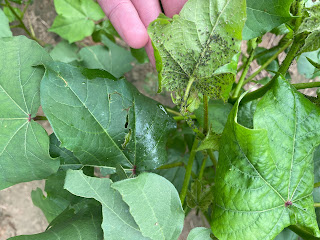We have gotten some much needed rains in some fields in parts of the state, while other are missing rains still. A lot of the cotton we have seen in central Alabama appears to have turned the corner over the past 7 days and is looking good. In the north, we have seen some fields that looked great and some that needed rain desperately. In conversations with most folks across Alabama, the situation depends on which field you are standing in and what day of the week you are in it.
 |
| Aphids in cotton |
Speaking of plant bugs, most of the reports we have been receiving
are that populations are spotty and that in many cases, nymphs are still very small
and just beginning to hatch. Depending on the age of the cotton and size of the
plant bug population, we may can go out with a “plant bug material” like
Transform (1.5-1.75 oz/A). If high populations of plant bugs are in the field,
Transform is the best option for control. If the cotton is still around the first
week of bloom, that is also a good time to consider a tank-mix of the insect growth
regulator, Diamond (6oz). As the cotton matures into the 3rd or 4th
week of bloom, however, we need to go with something that will also kill stink
bugs. We are expecting a heavy stink bug year and have already begun hearing about
stink bugs requiring attention in fields of south Alabama. One other comment on
Diamond and plant bugs. There are two ways to maximize the effects of this material.
Number 1: apply it at the first appearance of nymphs. This ensures that we don’t
waste any residual “on the front end” and maximize the ≈2 weeks suppression out of it.
Number 2: Don’t spray another chemical that would control plant bugs during the
following ≈2
weeks. If we are so close to the stink bug window that an application will likely
need to be made in the next week, we will not have needed the residual of
Diamond as long. Just a couple of things to consider when looking at
insecticide budgets for 2022.
If we want to control the “bug complex” (plant bugs + stink
bugs) we really only have a few options. Acephate (0.75 lb), Bidrin (6 oz) or bifenthrin
(6.4 oz). Although stink bugs prefer bolls that are 10-12 days old (about the diameter
of a quarter), they will feed on smaller “thumb-sized” bolls if few quarter-sized
bolls are available (during early bloom). Keep in mind our thresholds are
dynamic and vary during the week of bloom (see picture). To sample, pull a
minimum of 15-20 bolls that are 10-12 days old (about the size of a quarter)
from the field (not all from the border) from at least 2 areas within the
field. Bust the bolls open and look for warts, stained lint, or “pinprick” marks
on the inside of the boll wall.
If you need to pick up aphids and control bugs, consider adding imidacloprid to the bug complex materials above. Transform is an excellent aphid material and would not need a tank-mix for aphids but tank-mixing a pyrethroid if some stink bugs are in the field would be beneficial.
One final note. In response to a farmer request, the Alabama Extension Agronomics Crops Team is conducting a survey to better understand the impacts of deer population on crop production. Please take a few moments to help us collect informtaion to try to use to figure out ways to mitigate deer losses in your row crops.
You can take the anonymous survey here (link).
If you would like to provide reports or observations on the insect situation from your region, please let us know. You can reach Scott Graham at 662-809-3368 or scottg@auburn.edu or Ron Smith at 334-332-9501 or smithrh@auburn.edu.
As always, if we can ever be of any help, please let us
know.
